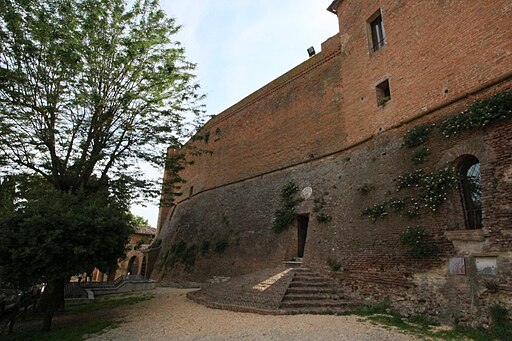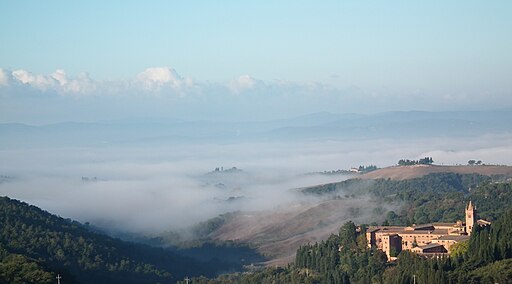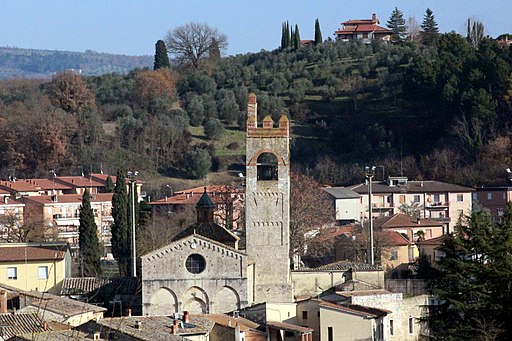| |
|
 |
 |
|
![Toacana ] Galleria di immagini](../../titels/albump.gif) |
|
| |
 |
|
|
| |
|
The Crete Senesi | The Castle of San Giovanni d’Asso | Inner Entrance to the Castle
|
|
|
|
| |
|
San Giovanni d'Asso is a comune in the area known as the Crete Senesi, in the heart of the white truffle territory. The hamlet is overlooked by a large Castle which dates back to the Sixteenth century.
Location 43° 09′ 10.1″ N, 11° 35′ 23.13″ E 
The most common types of stone used in Tuscany are sandstone and limestone, quarried in the hills of the Tuscan countryside. The castle in San Giovanni d’Asso, originally a Lombard construction, was replaced by a brick structure between the 12th and 14th centuries, in various stages.[2]
The building, made up of three buildings joined together, was built in several stages between 1100 and the first half of the 15th century; Particularly important are the works carried out by the Petroni family, who acquired the castle at the beginning of the 14th century. In the year 1539, Benedetto del fu Giovanni di Benedetto Martinozzi sold the palace (already the Castle), the lands and the rights to San Giovanni d'Asso to Giulio Pannilini [3]. The Pannilini family retained its possession until the beginning of the last century. Following major restoration work, completed in 1999, the castle houses both municipal offices, the comune, and the Tartufo Museum. [4]
|
 |
|
 |
|
 |
San Giovanni d'Asso
|
|
Castle San Giovanni d'Asso, seen fromthe south |
|
Castle San Giovanni d'Asso, Inner Entrance to the Castle
|
 |
|
 |
|
 |
|
|
La facciata principale con il grande portone ad arco senese della Rocca di San Giovanni d'Asso
|
|
Il cortile interno del Castello di San Giovanni d'Asso |
The main facade of the castle is to the north and is accessed from Piazza Gramsci square. The facade is characterized by Sienese arches. A second entrance is on the eastern side, which gives onto Piazza Vittorio Emanuele II, in the heart of the ancient village. The two entrances are joined by two steps of passage through the courtyard, characterized by a high portico on octagonal pillars surmounted by a loggia. [5]
The most important environment of the palace is the Fire Room, la Sala del caminetto, with access to the courtyard and a large mullet along the west side. The Sala del caminetto takes its name from the large fireplace that opens to the center of the south wall, opposite to the 17th-century marble washbasin.
The walls are decorated with frescoes from the end of the sixteenth century to the beginning of the 17th century by painters around Ventura Salimbeni. There is a grotesque little under the ceiling and three coats of arms of important members of the Pannilini family and their consorts.[5]
The castle now hosts the Truffle Museum, the first museum in Italy dedicated to the tasty tuber.
Museo del Tartufo
Piazza Antonio Gramsci 1
San Giovanni d'Asso
Website | Museo del tartufo
|
|
|
|
| |
|
|
Mappa San Giovanni d'Asso | Ingrandire mappa
|
The comune San Giovanni d'Asso included the hamlets of Montisi, Lucignano d'Asso, Monterongriffoli, Vergelle and Pieve a Salti.
From January 1,2017 the municipalities of San Giovanni d'Asso and Montalcino were united into one comune. San Giovanni d'Asso is now part of a larger comune, named Montalcino.
|
|
|
#poderesantapia Monte Amiata, vista da San Giovanni d'Asso, bellissimo panorama
|
| |
|
|
|
|
|
|
| |
|

Comune San Giovanni d'Asso | Official website
Traveling in Tuscany | Collegium Vocale Crete Senesi
J. Cassar, M.G. Winter, B.R. Marker, N.R.G. Walton, D.C. Entwisle, E.N. Bromhead, J.W.N. Smith, Geological Society of London, 30 apr. 2014, Stone in Historic Buildings: Characterization and Performance | books.google.be/books
Tuscan architecture: the stones through the centuries
Starting from the Etruscan - Roman period, archaeological evidence indicates the use of strictly IocaI building materials Iike the calcarenites along the Tyrrhenian coast (Pisa and Populonia) and in Volterra, while, on the foothilIs of the Apennines, the Etruscan Fiesoie and Cortona are characterized by the use of a quartz-feldspar sandstone (Pietra Serena), clearly visible in the large blocks of the city walls.
In the Middle Ages, the materials used were still local. Pisa and Lucca are characterized mainly by the use of the quartzites of Monte Pisano, Massa Marittima (the old Massa Metallorum) by travertine, and Siena and San Gimignano by a vacuolar limestone (Calcare Cavernoso) and later on by bricks. The cities in the foothills of the Apennines, such as Arezzo, Cortona and Pistoia, were still characterized by the Pietra Serena, while Florence was built from another kind of sandstone, Pietraforte. However, Prato, which is between Florence and Pistoia, was built using the local marly limestone, known as Alberese. [p 71]
|

|
|
|
 |
|
 |
|
|
Crete Senesi presso Asciano
|
|
Monte Oliveto Maggiore |
|
Monte Oliveto Maggiore, Campanile]
|
 |
|
 |
|
 |
| Crete Senesi, balle di fieno |
|
Pieve di Santo Stefano a Cennano. Absidi
|
|
Chiusure and the Campanile of Santa Maria di Monte Oliveto Maggiore
|
 |
|
|
|
|
Asciano
|
|
|
|
|


Hidden secrets in Tuscany | Holiday house Podere Santa Pia
|
 |
Bibliography
Emanuele Repetti, Dizionario Geografico, Fisico e Storico della Toscana, vol. 1, Firenze, E. Repetti, 1833
Pietro Rossi, Documenti e statuti del castello di Montisi (1197-1552), Siena, Tip. e lit. sordo-muti di L. Lazzeri, 1990
AA.VV., La chiesa di S. Pietro in Villore ed altre emergenze architettoniche del territorio di S. Giovanni d'Asso, Siena, Università degli Studi, 1981
Carlo Prezzolini, Chiesa di S. Giovanni d'Asso e Montisi in età moderna, in Bullettino senese di Storia Patria, XCII, Siena, Accademia senese degli Intronati, 1985, ISBN non esistente.
Touring Club Italiano (a cura di), Toscana, Milano, Touring Editore, 1997, ISBN 88-365-0948-7
Giò Pozzo, Guida alle città del tartufo, Milano, Touring Editore, 2000, ISBN 88-365-1831-1
Mario Brogi, Michelangelo Lorenzoni, L'archivio comunale di San Giovanni d'Asso (PDF), Siena, Cantagalli, 2010, ISBN non esistente.
Franco Paturzo e Gianni Brunacci, Le pievi aretine: la millenaria storia di un territorio, Arezzo, Letizia, 2012, ISBN 978-88-95520-22-3.

[1] Foto di LigaDue, licenziato in base ai termini della licenza Creative Commons Attribution-Share Alike 3.0 Unported
[2] J. Cassar, M.G. Winter, B.R. Marker, N.R.G. Walton, D.C. Entwisle, E.N. Bromhead, J.W.N. Smith, Geological Society of London, 30 apr. 2014, Stone in Historic Buildings: Characterization and Performance | books.google.be/books
[3] Tuscany charming, Il territorio di San Giovanni d'Asso è un esempio raro di connubio armonico tra natura e l'impronta dell'uomo., tuscany-charming.it.
[4] Castello di S. Giovanni d'Asso, su castellitoscani.com. URL consultato l'11 settembre 2014.
[5] V. Passeri, Il Castello di S. Giovanni d'Asso, in AA.VV., p. 93.
[6] Castello di San Giovanni d'Asso, su comune.sangiovannidasso.siena.it. URL consultato l'11 settembre 2014.
|
Questo articolo è basato parzialmente sull'articolo San Giovanni d'Asso dell' enciclopedia Wikipedia ed è rilasciato sotto i termini della GNU Free Documentation License.
|
|
|
| |
|
|
|
| |
|
|
|
| |
|
|
|
| |
|
|
|
| |
|
|
|
| |
|
|
|
|